Are there sharks in Los Cabos, Mexico? Absolutely, and gaymexico.net is your premier guide to safely exploring these waters, offering insights into incredible marine life encounters tailored for the LGBTQ+ community, ensuring thrilling adventures alongside whale sharks and more. Discover responsible ecotourism and underwater adventures in Mexico.
1. What Shark Species Can You Find in Los Cabos, Mexico?
Los Cabos, Mexico, boasts a diverse marine ecosystem, making it a hotspot for various shark species. From the gentle whale shark to the swift mako, the waters here offer thrilling encounters for divers and marine enthusiasts. The variety of sharks in Los Cabos is a testament to the rich biodiversity of the Sea of Cortez.
Here’s a list of shark species you might encounter:
- Silky Shark (Carcharhinus falciformis)
- Mako Shark (Isurus oxyrinchus)
- Hammerhead Shark (Sphyrna zygaena & Sphyrna lewini)
- Blue Shark (Prionace glauca)
- Whale Shark (Rhincodon typus)
- Bull Shark (Carcharhinus leucas)
- Great White Shark (Carcharodon carcharias)
2. Where Can You Swim With Sharks in Los Cabos?
Swimming with sharks in Los Cabos is an unforgettable experience, and several locations offer opportunities to do so responsibly. These tours typically emphasize conservation and respect for the marine environment. Ethical tourism ensures these majestic creatures are protected for future generations.
- Cabo San Lucas: Serves as a starting point to venture into shark diving spots.
- La Paz: Whale sharks are abundant in the waters near La Paz, on the other side of the peninsula.
- Cabo Pulmo National Park: A great spot to see bull sharks year-round.
- Guadalupe Island: While further offshore, this is the place for great white shark encounters.
3. When Is the Best Time to See Sharks in Los Cabos?
The best time to see sharks in Los Cabos varies depending on the species you’re hoping to encounter. Seasonal migrations and mating patterns influence shark presence. Knowing the optimal viewing times enhances your chances of a successful shark encounter.
Here’s a seasonal guide to shark sightings:
| Shark Species | Best Time to See |
|---|---|
| Silky Shark | June to January |
| Mako Shark | December to June |
| Hammerhead Shark | January to August |
| Blue Shark | December to Late April |
| Whale Shark | October to April (La Paz) |
| Bull Shark | Year-Round (Cabo Pulmo) |
| Great White Shark | N/A (Guadalupe Island) |
4. Are Shark Diving Tours in Los Cabos Safe?
Shark diving tours in Los Cabos prioritize safety through experienced guides and strict protocols. Reputable tour operators ensure participant safety while promoting responsible interaction with sharks. Certified professionals know how to handle shark encounters safely.
Safety measures commonly include:
- Briefing on shark behavior
- Use of appropriate diving gear
- Monitoring by experienced guides
- Adherence to conservation guidelines
5. How Can LGBTQ+ Travelers Find Shark Diving Tours in Los Cabos?
LGBTQ+ travelers can discover welcoming shark diving tours in Los Cabos by researching inclusive operators. Look for companies with positive LGBTQ+ reviews and a commitment to diversity. Online forums and travel communities are great resources.
Tips for finding LGBTQ+-friendly tours:
- Check online reviews for LGBTQ+ experiences
- Contact tour operators directly to inquire about their inclusivity policies
- Seek recommendations from LGBTQ+ travel groups
- Look for operators supporting LGBTQ+ rights
6. What Safety Precautions Should You Take When Swimming With Sharks?
When swimming with sharks, adhere to all safety guidelines provided by the tour operator. Remain calm, avoid sudden movements, and maintain a respectful distance. Following expert advice ensures a safe and memorable experience.
Key safety precautions include:
- Listen carefully to the pre-dive briefing
- Stay close to the group
- Avoid wearing shiny jewelry
- Do not feed or touch the sharks
7. What is the Cost of Shark Diving Tours in Los Cabos?
The cost of shark diving tours in Los Cabos varies depending on the duration, location, and species. Prices can range from affordable snorkeling tours to more expensive liveaboard expeditions. Budgeting ahead ensures you find a tour that fits your financial comfort.
Cost factors to consider:
- Type of shark (e.g., whale shark vs. great white)
- Duration of the tour
- Included amenities (e.g., equipment rental, meals)
- Group size
8. How Can You Ensure a Sustainable Shark Diving Experience?
Ensure a sustainable shark diving experience by choosing tour operators committed to conservation. Support companies that follow responsible tourism practices and contribute to shark research and protection. Your choices impact the health of marine ecosystems.
Practices for sustainable shark diving:
- Choosing operators certified in sustainable tourism
- Avoiding tours that feed sharks
- Respecting marine protected areas
- Educating yourself about shark conservation
9. What Other Marine Wildlife Can You See in Los Cabos?
In addition to sharks, Los Cabos is teeming with other marine wildlife, including dolphins, whales, sea turtles, and vibrant reef fish. This biodiversity makes every dive a unique and exciting adventure. The Sea of Cortez is renowned for its rich aquatic life.
Other marine species you might encounter:
- Dolphins
- Humpback whales
- Sea turtles
- Manta rays
- Colorful reef fish
10. How Does Shark Conservation Impact Los Cabos?
Shark conservation efforts are crucial for maintaining the health of marine ecosystems in Los Cabos. Protecting sharks helps preserve biodiversity and supports the local economy through sustainable tourism. Conservation ensures future generations can enjoy these incredible creatures.
Benefits of shark conservation:
- Maintains healthy food chains
- Supports sustainable tourism
- Protects biodiversity
- Ensures future generations can enjoy marine life
11. What Should I Know About Silky Sharks in Cabo San Lucas?
Silky sharks are known for their smooth skin and often gather in large schools, especially during mating season in July and August. Cabo San Lucas is a great place to observe these sharks as they interact with other predators while hunting sardine bait balls. Divers can have close encounters with these sharks between June and January.
Interesting facts about silky sharks:
- They have silky-smooth skin.
- They are highly migratory.
- They mate in Baja California in July and August.
- They can be seen hunting with other predators.
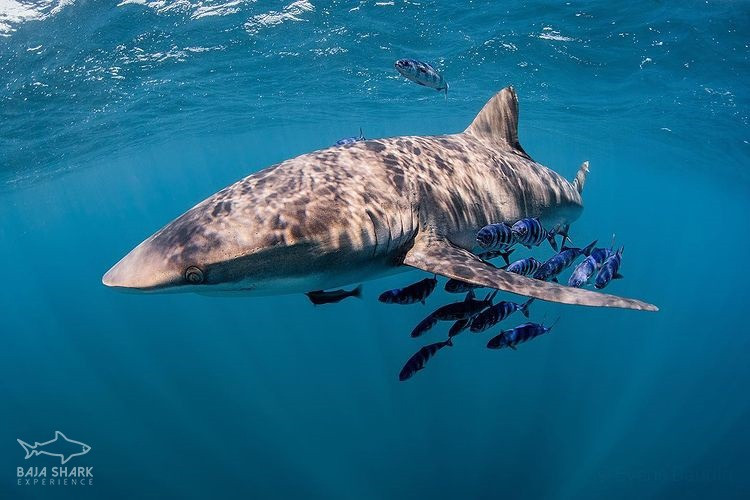 Silky Shark
Silky Shark
12. What Makes Mako Sharks Special?
Mako sharks are the fastest sharks in the world, known for their incredible speed and agility. These torpedo-shaped hunters are capable of breaching, launching themselves out of the water while hunting. They are most commonly seen off the coast of Cabo from December to June.
Key features of mako sharks:
- They are the fastest shark species.
- They have a torpedo-like body for speed.
- They can breach out of the water.
- They are agile hunters.
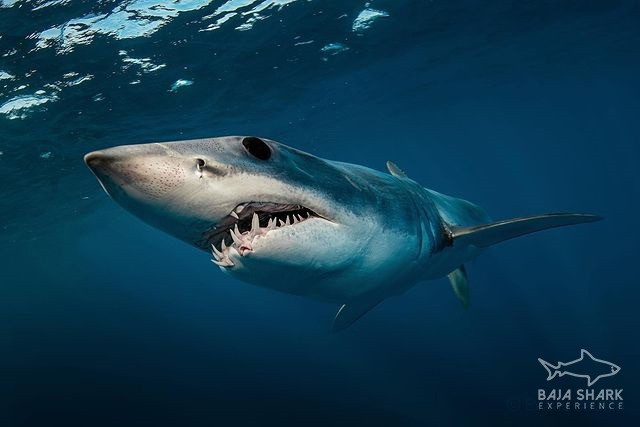 Mako Shark
Mako Shark
13. How Can I Identify Hammerhead Sharks in Los Cabos?
Hammerhead sharks are easily identifiable by their unique head shape, which gives them nearly 360-degree vision. The smooth hammerhead and scalloped hammerhead are two species frequently spotted around Cabo. You can observe them in Baja California from January to August.
Characteristics of hammerhead sharks:
- They have a distinct hammer-shaped head.
- Their wide-set eyes provide almost 360-degree vision.
- Smooth and scalloped hammerheads are common in Cabo.
- They are present from January to August.
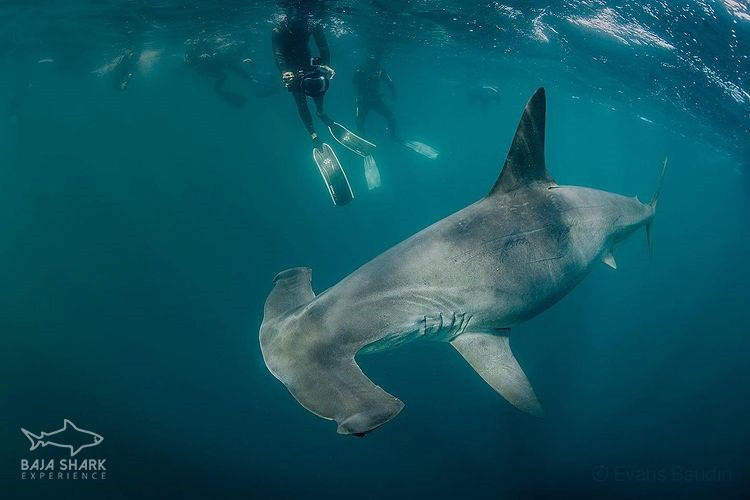 Hammerhead Shark
Hammerhead Shark
14. What Should I Know About Blue Sharks?
Blue sharks are named for their iridescent cobalt blue skin, which provides excellent camouflage in the ocean. They have sharp vision, which helps them hunt smaller fish and squid. Lucky divers can swim with blue sharks from December to the end of April.
Distinctive features of blue sharks:
- They have cobalt blue skin for camouflage.
- They have sharp vision for hunting.
- They primarily eat smaller fish and squid.
- They are visible from December to April.
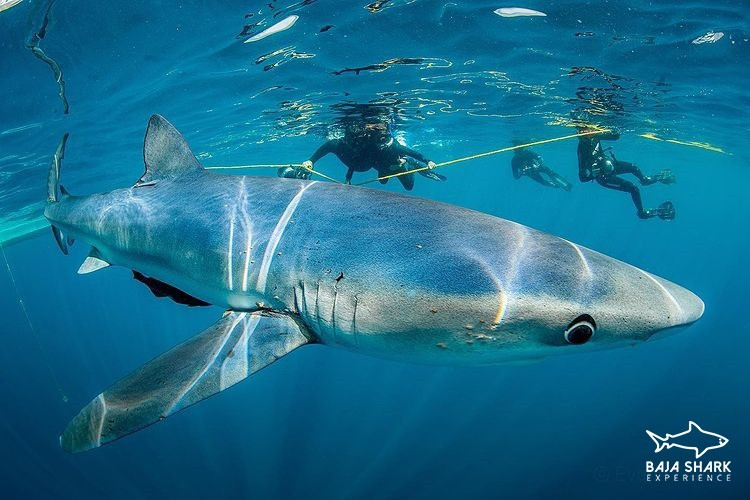 Blue Shark
Blue Shark
15. Why Are Whale Sharks Considered Gentle Giants?
Whale sharks are the largest sharks but are also the gentlest, feeding on plankton, krill, and small fish through filter-feeding. They are harmless to humans, making them perfect for family-friendly diving experiences. You can find them near La Paz from October to April.
Qualities of whale sharks:
- They are the largest shark species.
- They are filter feeders, eating plankton and small fish.
- They are harmless to humans.
- They are found near La Paz from October to April.
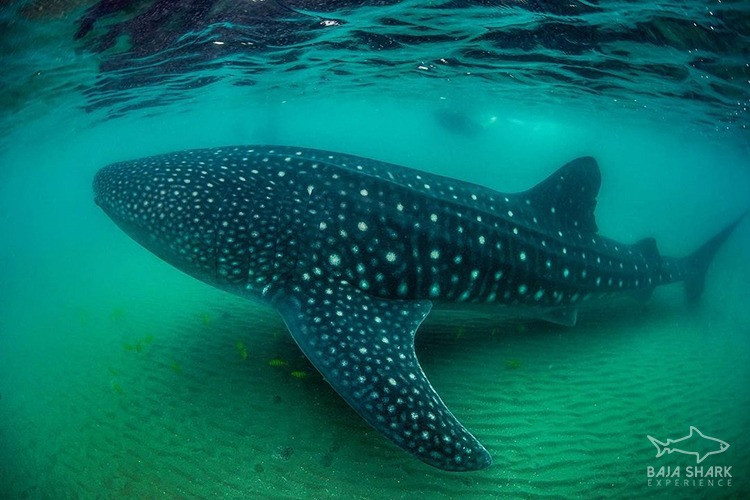 Whale Shark
Whale Shark
16. Where Can I See Bull Sharks in Los Cabos?
Bull sharks are often considered one of the most aggressive sharks, but they are not typically dangerous to humans. They can adapt to both saltwater and freshwater, allowing them to migrate through rivers. Cabo Pulmo National Park is a year-round habitat for bull sharks.
Characteristics of bull sharks:
- They are adaptable to both saltwater and freshwater.
- They are present year-round in Cabo Pulmo National Park.
- They are considered aggressive but rarely harm humans.
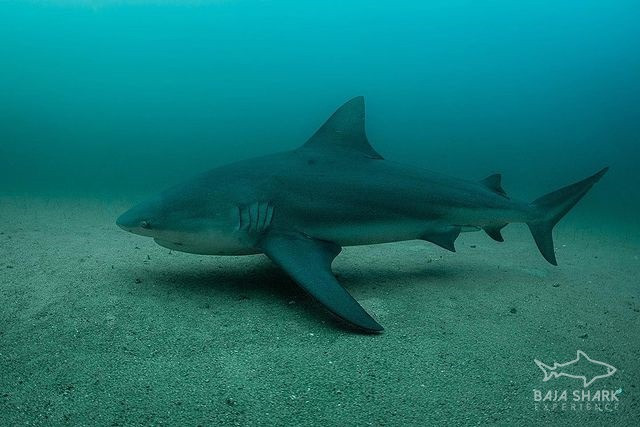 Bull Shark
Bull Shark
17. Is It Safe to Swim With Great White Sharks in Los Cabos?
While great white sharks are present in the region, they are not commonly found near the shores of Cabo San Lucas. To encounter great whites, you typically need to take a liveaboard to Guadalupe Island, about 150 miles off the coast. These expeditions are conducted with strict safety measures.
Information about great white sharks:
- They are not typically found near Cabo San Lucas shores.
- Encounters require a trip to Guadalupe Island.
- They are the largest predatory fish on the planet.
- Expeditions are conducted with strict safety protocols.
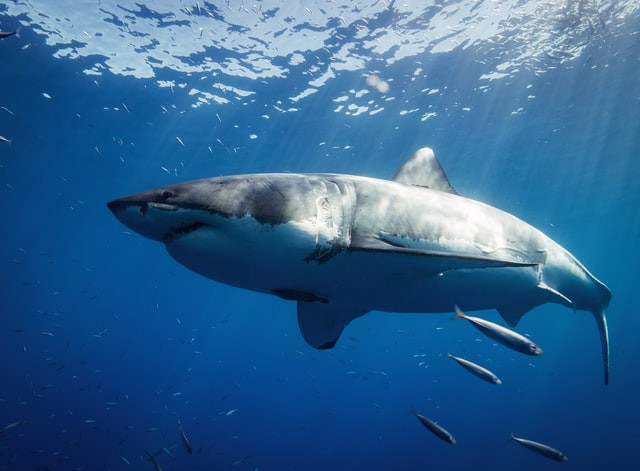 Great White Shark
Great White Shark
18. What Are the Unique Opportunities for Shark Diving in Cabo San Lucas?
Cabo San Lucas offers unique opportunities to swim with diverse shark species, making it a prime location for shark diving. With Baja Shark Experience, you can safely swim with these magnificent creatures in the open ocean. Expert guides provide education and assistance, ensuring a life-changing adventure.
What makes shark diving in Cabo San Lucas special:
- Diverse shark species in one location
- Safe open ocean swimming experiences
- Expert guides providing education and assistance
- Opportunities for custom and private trips
19. How Can I Plan a Personalized Shark Diving Trip in Los Cabos?
If you’re looking for a more personalized experience or want to organize a private trip for your group, custom expeditions can be arranged. Expert guides can work with professional photographers and film crews to help you get the perfect shots of these apex predators. Contact Baja Shark Experience to plan your dream shark diving trip.
Tips for planning a personalized shark diving trip:
- Contact tour operators for custom options
- Arrange private trips for your group
- Involve professional photographers for the best shots
- Plan expeditions tailored to your specific interests
20. What Can LGBTQ+ Travelers Expect from Diving in Los Cabos?
LGBTQ+ travelers can expect a welcoming and inclusive atmosphere when diving in Los Cabos. Many tour operators prioritize diversity and respect for all participants. By choosing inclusive operators and engaging with LGBTQ+ travel communities, you can ensure a comfortable and enjoyable experience.
What to expect for LGBTQ+ divers in Los Cabos:
- Welcoming and inclusive tour operators
- Diverse and respectful environment
- Opportunities to connect with LGBTQ+ travel communities
- Safe and enjoyable diving experiences
21. Are There Shark Attacks in Los Cabos?
Shark attacks in Los Cabos are rare. Most shark species in the area are not aggressive towards humans, and incidents are infrequent. Responsible tourism practices further minimize the risk. Understanding shark behavior helps maintain safety.
Facts about shark attacks in Los Cabos:
- Shark attacks are rare.
- Most local species are not aggressive towards humans.
- Responsible tourism practices minimize risk.
- Understanding shark behavior is crucial for safety.
22. What Legal Protections Exist for Sharks in Mexico?
Mexico has implemented several legal protections for sharks, including regulations on fishing and trade. These measures aim to conserve shark populations and promote sustainable tourism. Legal frameworks are essential for marine conservation.
Key legal protections for sharks in Mexico:
- Regulations on shark fishing
- Restrictions on shark trade
- Establishment of marine protected areas
- Enforcement of conservation laws
23. How Can I Contribute to Shark Research in Los Cabos?
Contributing to shark research in Los Cabos can involve participating in citizen science projects, donating to conservation organizations, or supporting research-focused tour operators. Your involvement helps advance scientific understanding of these creatures. Every contribution aids shark conservation.
Ways to support shark research:
- Participate in citizen science projects
- Donate to conservation organizations
- Support research-focused tour operators
- Share research findings with others
24. What Role Do Sharks Play in the Marine Ecosystem of Los Cabos?
Sharks play a critical role in the marine ecosystem of Los Cabos as apex predators, maintaining balance and biodiversity. Their presence indicates a healthy and thriving environment. Protecting sharks preserves the entire ecosystem.
Importance of sharks in the ecosystem:
- They are apex predators that maintain balance.
- Their presence indicates a healthy ecosystem.
- They support biodiversity.
- Their protection ensures ecosystem health.
25. Where Can LGBTQ+ Travelers Find More Information About Los Cabos?
LGBTQ+ travelers can find more information about Los Cabos on gaymexico.net, which offers comprehensive guides, event listings, and community resources. This website provides valuable insights for LGBTQ+ visitors, ensuring a safe and enjoyable trip. Your go-to resource for LGBTQ+ travel is here.
Resources for LGBTQ+ travelers:
- gaymexico.net for comprehensive guides and resources
- LGBTQ+ travel blogs and forums
- Local LGBTQ+ community centers
- Inclusive tour operators and accommodations
26. What Makes Los Cabos a Great Destination for LGBTQ+ Travelers?
Los Cabos is increasingly recognized as a welcoming destination for LGBTQ+ travelers. The city offers a mix of luxury resorts, vibrant nightlife, and stunning natural beauty. Embracing diversity enhances the travel experience.
Reasons Los Cabos is great for LGBTQ+ travelers:
- Welcoming and inclusive atmosphere
- Luxury resorts and vibrant nightlife
- Stunning natural beauty
- Growing LGBTQ+ community
27. What LGBTQ+ Events and Festivals Take Place in Los Cabos?
Los Cabos hosts various LGBTQ+ events and festivals throughout the year, celebrating diversity and community. These events offer opportunities for socializing and cultural exchange. Check local listings for the latest happenings.
Examples of LGBTQ+ events:
- Pride celebrations
- Film festivals
- Community gatherings
- Themed parties
28. What Are the Best LGBTQ+-Friendly Accommodations in Los Cabos?
Los Cabos offers numerous LGBTQ+-friendly accommodations, ranging from boutique hotels to all-inclusive resorts. These establishments prioritize inclusivity and create a welcoming environment for all guests. Choose accommodations that align with your values.
Types of LGBTQ+-friendly accommodations:
- Boutique hotels
- All-inclusive resorts
- Vacation rentals
- Bed and breakfasts
29. How Can LGBTQ+ Travelers Stay Safe in Los Cabos?
LGBTQ+ travelers can stay safe in Los Cabos by exercising common sense, avoiding isolated areas at night, and being aware of their surroundings. Generally, Los Cabos is safe, but caution is always advised. Travel smart and stay informed.
Safety tips for LGBTQ+ travelers:
- Exercise common sense
- Avoid isolated areas at night
- Be aware of your surroundings
- Trust your instincts
30. What Are Some Key Phrases to Know in Spanish?
Knowing a few key phrases in Spanish can enhance your travel experience in Los Cabos. Simple greetings and expressions of gratitude go a long way. Language skills foster cultural connections.
Useful Spanish phrases:
- Hola (Hello)
- Gracias (Thank you)
- De nada (You’re welcome)
- Por favor (Please)
- ¿Cómo está? (How are you?)
31. What Are the Best Beaches to Visit in Los Cabos?
Los Cabos is famous for its beautiful beaches, each offering unique attractions. From Lover’s Beach accessible by boat to the surfing waves of Costa Azul, there is a beach for everyone.
Some top beaches include:
- Medano Beach (Playa El Médano): Lively atmosphere, water activities, restaurants.
- Lover’s Beach (Playa del Amor): Secluded, stunning rock formations, clear waters.
- Chileno Beach (Playa Chileno): Excellent for snorkeling and diving, calm waters.
- Santa Maria Beach (Playa Santa María): Protected cove, ideal for swimming, calm waters.
- Costa Azul: Surfing destination.
32. What Are the Top Activities and Attractions in Los Cabos?
Beyond beaches and shark diving, Los Cabos boasts a variety of activities and attractions:
- El Arco: A natural rock formation at Land’s End, iconic symbol of Los Cabos.
- Cabo San Lucas Marina: Hub for fishing charters, water taxis, and nightlife.
- Art Walk in San Jose del Cabo: Every Thursday evening from November to June.
- Luxury Spas and Resorts: Relax and rejuvenate in world-class facilities.
- Golf Courses: Renowned golf courses designed by top players.
33. What Are Some Responsible Travel Tips for Los Cabos?
Being a responsible traveler ensures that the natural environment and local community benefit from tourism:
- Support Local Businesses: Eat at locally-owned restaurants and buy souvenirs from local artisans.
- Conserve Resources: Save water and electricity, and reduce waste.
- Respect Local Culture: Learn about local customs and traditions, and dress appropriately.
- Reduce Plastic Use: Bring a reusable water bottle and shopping bag.
- Choose Eco-Friendly Tours: Select tour operators committed to sustainability.
34. Where Can I Find Reliable Information on Local Laws and Customs?
Reliable information on local laws and customs is crucial for a smooth trip.
Here are some resources:
- Travel Guides: Lonely Planet, Frommer’s, and other guidebooks offer practical advice.
- Government Websites: Check the U.S. State Department or your country’s travel advisory website.
- Online Forums: TripAdvisor and other travel forums provide insights from fellow travelers.
- Local Tourism Boards: The Los Cabos Tourism Board website can offer accurate information.
35. What Are the Options for Transportation in Los Cabos?
Getting around Los Cabos is relatively easy with several options:
- Taxis: Widely available, but negotiate the fare beforehand.
- Ride-Sharing Services: Uber and other services operate in certain areas.
- Car Rentals: Suitable if you plan to explore beyond the main tourist areas.
- Public Buses: Affordable way to travel between towns, but can be crowded.
- Water Taxis: For accessing beaches and landmarks from the marina.
36. How Can I Support the LGBTQ+ Community in Los Cabos?
Supporting the LGBTQ+ community in Los Cabos is a great way to give back.
You can do this by:
- Patronizing LGBTQ+-Owned Businesses: Support local businesses that are owned and operated by LGBTQ+ individuals.
- Donating to Local LGBTQ+ Organizations: Contribute to organizations that provide support and advocacy.
- Attending LGBTQ+ Events: Participate in local events and festivals that celebrate diversity.
- Volunteering Your Time: Offer your time and skills to support community initiatives.
- Being an Ally: Show support and respect for LGBTQ+ individuals in your interactions.
37. How Can I Stay Connected with the LGBTQ+ Community in Mexico?
To stay connected:
- gaymexico.net is your ultimate resource for LGBTQ+ travel in Mexico.
- Address: 3255 Wilshire Blvd, Los Angeles, CA 90010, United States
- Phone: +1 (213) 380-2177
- Website: gaymexico.net
Embark on your ultimate shark adventure in Los Cabos!